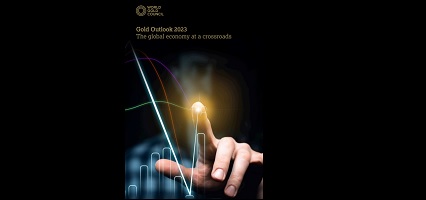Report warns if central banks tightened rates more than necessary, it could result in severe & widespread downturn; while abrupt reversing could lead to stagflation

The World Gold Council’s Gold Outlook 2023 global outlook report begins with a commentary on the market sentiment stating that the “global economy is at an inflection point after being hit by various shocks over the past year”. The biggest inflection according to WGC was induced by central banks as they stepped up their aggressive fight against inflation. This interplay between inflation and central-bank intervention will be vital in determining the outlook for 2023 and gold’s performance the report notes. “Economic consensus calls for weaker global growth akin to a short, possibly localised recession; falling – yet elevated – inflation; and the end of rate hikes in most developed markets,” the report details. In this environment which carries both headwinds and tailwinds for gold, WGC’s key take-aways are mentioned as listed below:
- A mild recession and weaker earnings have historically been gold-positive
- Further weakening of the dollar as inflation recedes could provide support for gold
- Geopolitical flare-ups should continue to make gold a valuable tail risk hedge
- Chinese economic growth should improve next year, boosting consumer gold demand
- Long-term bond yields are likely to remain high but at levels that have not hampered gold historically
- Pressure on commodities due to a slowing economy is likely to provide headwinds to gold in H1
The mixed set of influences implies a stable but positive performance for gold. The reports states that there is an unusually high level of uncertainty surrounding consensus expectations for 2023. “For example, central banks tightening more than is necessary could result in a more severe and widespread downturn. Equally, central banks abruptly reversing course – halting or reversing hikes before inflation is controlled – could leave the global economy teetering close to stagflation.” Finally stating that gold has historically responded positively to these environments; on the flipside, a less likely ‘soft landing’ that avoids recession could be detrimental to gold and benefit risk assets,” it states.
Commenting on the global scenario, Jaun Carlos Artigas, Global Head of Research, World Gold Council said, “The global economy is facing a crossroads, as major central banks continue their efforts to stifle inflation. Gold’s performance in the new year will be shaped by the intertwining effects of economic growth, interest rates and inflation, in addition to the influence of geopolitics and the still-strong US dollar. The economic consensus indicates weaker global growth alongside declining – but still elevated – inflation, in addition to minimized rate hikes in most markets. Amid those conditions, the 2023 outlook for gold is one of stable performance, especially given its role as both a consumer good and investable asset. However, there is considerable chance that central banks will over-tighten, leading to a more acute recession. In this scenario, gold’s value as a long-term, strategic investable asset will come into focus, given it has delivered positive returns in five out of the last seven recessions.”
Be the first to comment